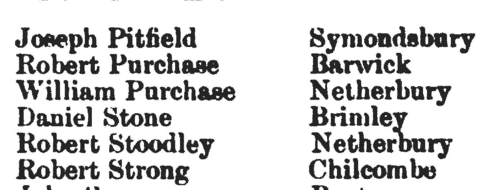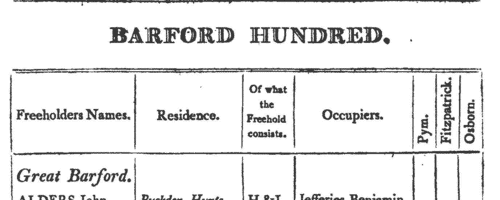Add this eBook to your basket to receive access to all 90 records. Our indexes include entries for the spelling fookes. In the period you have requested, we have the following 90 records (displaying 21 to 30): These sample scans are from the original record. You will get scans of the full pages or articles where the surname you searched for has been found. Your web browser may prevent the sample windows from opening; in this case please change your browser settings to allow pop-up windows from this site.  Masters and Apprentices
(1735) Masters and Apprentices
(1735)
Apprenticeship indentures and clerks' articles were subject to a 6d or 12d per pound stamp duty: the registers of the payments usually give the master's trade, address, and occupation, and the apprentice's father's name and address, as well as details of the date and length of the apprenticeship. 5 April to 31 December 1735 | Sample scan, click to enlarge

|  Apprentices registered in Dorset
(1756) Apprentices registered in Dorset
(1756)
Apprenticeship indentures and clerks' articles were subject to a 6d or 12d per pound stamp duty: the registers of the payments usually give the master's trade, address, and occupation, and the apprentice's name, as well as details of the date and length of the apprenticeship. There are central registers for collections of the stamp duty in London, as well as returns from collectors in the provinces. These collectors generally received duty just from their own county, but sometimes from further afield. The indentures themselves can date from a year or two earlier than this return. (The sample entry shown on this scan is taken from a Liverpool return. Each entry has two scans, the other being the facing page with the details of the indenture, length of service, and payment of duty.) IR 1/52 | Sample scan, click to enlarge

|  Apprentices registered in Shaftesbury
(1769) Apprentices registered in Shaftesbury
(1769)
Apprenticeship indentures and clerks' articles were subject to a 6d or 12d per pound stamp duty: the registers of the payments usually give the master's trade, address, and occupation, and the apprentice's name, as well as details of the date and length of the apprenticeship. There are central registers for collections of the stamp duty in London, as well as returns from collectors in the provinces. These collectors generally received duty just from their own county, but sometimes from further afield. The indentures themselves can date from a year or two earlier than this return. (The sample entry shown on this scan is taken from a Durham return. Each entry has two scans, the other being the facing page with the details of the indenture, length of service, and payment of duty.) IR 1/57 | Sample scan, click to enlarge

|  Apprentices registered in Dorsetshire
(1773) Apprentices registered in Dorsetshire
(1773)
Apprenticeship indentures and clerks' articles were subject to a 6d or 12d per pound stamp duty: the registers of the payments usually give the master's trade, address, and occupation, and the apprentice's name, as well as details of the date and length of the apprenticeship. There are central registers for collections of the stamp duty in London, as well as returns from collectors in the provinces. These collectors generally received duty just from their own county, but sometimes from further afield. The indentures themselves can date from a year or two earlier than this return. (The sample entry shown on this scan is taken from a Bristol return. Each entry has two scans, the other being the facing page with the details of the indenture, length of service, and payment of duty.) IR 1/58 | Sample scan, click to enlarge

|  Masters of apprentices registered in Dorsetshire
(1773) Masters of apprentices registered in Dorsetshire
(1773)
Apprenticeship indentures and clerks' articles were subject to a 6d or 12d per pound stamp duty: the registers of the payments usually give the master's trade, address, and occupation, and the apprentice's name, as well as details of the date and length of the apprenticeship. There are central registers for collections of the stamp duty in London, as well as returns from collectors in the provinces. These collectors generally received duty just from their own county, but sometimes from further afield. The indentures themselves can date from a year or two earlier than this return. (The sample entry shown on this scan is taken from a Bristol return. Each entry has two scans, the other being the facing page with the details of the indenture, length of service, and payment of duty.) IR 1/58 | Sample scan, click to enlarge

|  Apprentices registered in Dorsetshire
(1778) Apprentices registered in Dorsetshire
(1778)
Apprenticeship indentures and clerks' articles were subject to a 6d or 12d per pound stamp duty: the registers of the payments usually give the master's trade, address, and occupation, and the apprentice's name, as well as details of the date and length of the apprenticeship. There are central registers for collections of the stamp duty in London, as well as returns from collectors in the provinces. These collectors generally received duty just from their own county, but sometimes from further afield. The indentures themselves can date from a year or two earlier than this return. (The sample entry shown on this scan is taken from a Bristol return. Each entry has two scans, the other being the facing page with the details of the indenture, length of service, and payment of duty.) IR 1/60 | Sample scan, click to enlarge

|  Apprentices and clerks
(1793) Apprentices and clerks
(1793)
Apprenticeship indentures and clerks' articles were subject to a 6d or 12d per pound stamp duty: the registers of the payments usually give the master's trade, address, and occupation, and the apprentice's name, as well as details of the date and length of the apprenticeship. 17 June to 31 December 1793. IR 1/36 | Sample scan, click to enlarge

| Dorset Volunteer Rangers
(1794)
A subscription of £1425 10s was raised in Dorset in 1794 towards the cost of 'forming Bodies of Men for the Internal Defence of the Country, not liable to be drawn out, except in cases of actual Invasion or Commotion'. On 17 September 1794 the whole corps was reviewed by king George III under Maiden Castle, 'who returned them thanks, and expressed much pleasure at seeing them so alert and forward in their manoeuvres'. The muster roll of the Dorset Volunteer Rangers gives the full name and parish for each volunteer. 'These men clothed and horsed themselves entirely at their own expense, without receiving one farthing from Government, except their sword, one pistol, and holsters.' | Sample scan, click to enlarge

| Sackville papers
(1685-1799)
R. B. Knowles of the Historical Manuscripts Commission was invited by Mrs Stopford-Sackville to examine her family papers at Drayton House in Northamptonshire; and after his death the work was continued by W. O. Hewlett and published in 1904. These were chiefly letters, reports and other official documents from and to lord George Sackville, the third son of Lionel first duke of Dorset. The papers edited in this volume relate to the Monmouth insurrection 1685-1686; letters of Mary princess of Orange to lady Mary Forester; Sackville family papers and letters 1706-1799; home affairs 1755-1784; letters from lord George to General Irwin 1761-1784; Ireland 1731-1783; the war of the Austrian Succession 1743-1748; Cherbourgh and St Malo 1758; the Seven Years War 1758-1759; Minden 1759-1760; Spain 1778-1780; prince William Henry duke of Gloucester 1771-1779; India 1776-1784; and Minorca 1776-1782. | Sample scan, click to enlarge

| Bedfordshire Freeholders and Occupiers: Chalgrave
(1807)
A poll for two knights of the shire for the county of Bedford, was taken at Bedford from 11 to 22 May 1807, the candidates being Francis Pym esquire (1138 votes), the Rt Hon Richard Fitzpatrick (1084) and John Osborn esquire (1069). The poll book is arranged by hundred, and then by parish or township, giving the freeholders' names, residence, 'of what the freehold consists' (e. g. H. & L. for house and land), the occupier, and the vote cast. Non-voters are not listed: but at the end of each hundred there is a list of rejected votes, giving full name of voter, situation of the property, ground of rejection, and candidates for whom the votes were tendered. | Sample scan, click to enlarge

|
Research your ancestry, family history, genealogy and one-name study by direct access to original records and archives indexed by surname.
|












